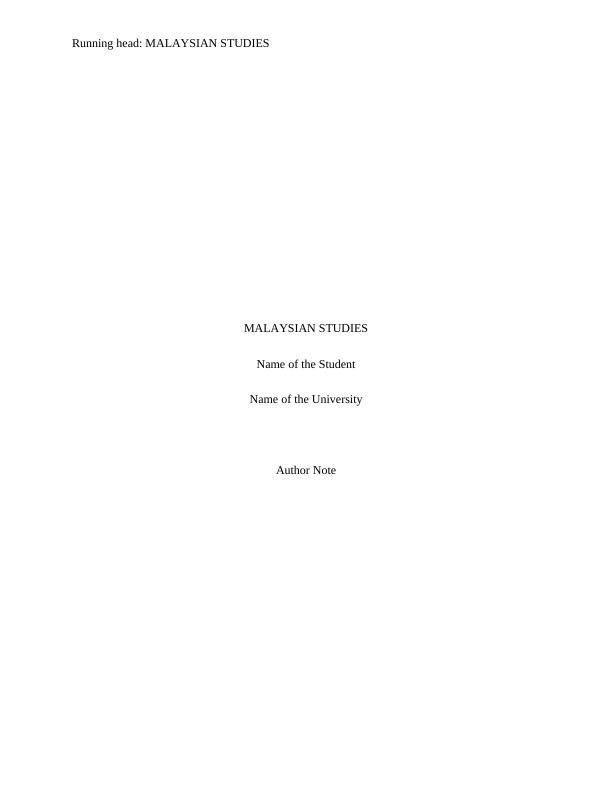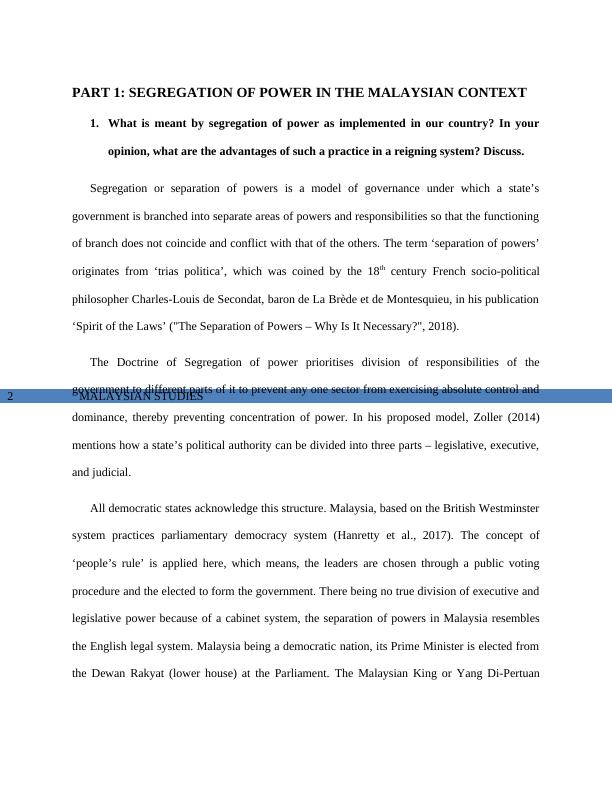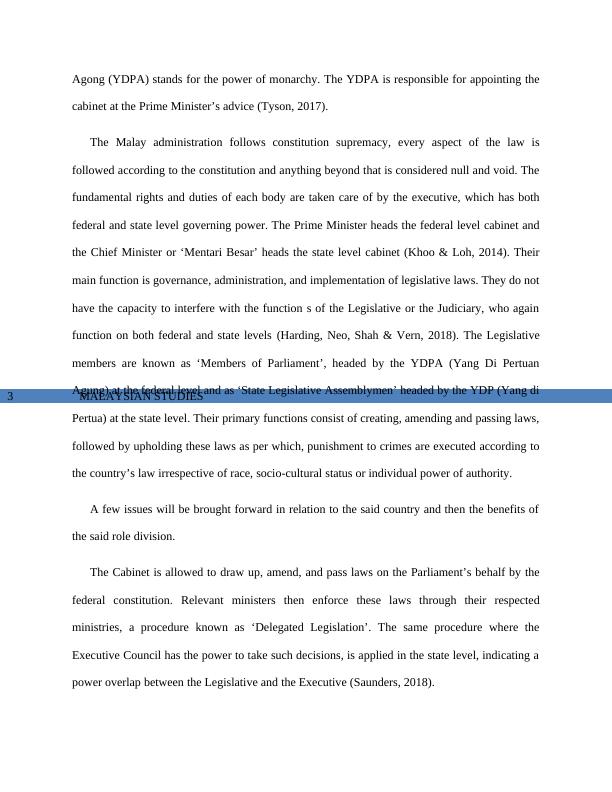Segregation of Power in Malaysia
Added on 2022-12-29
17 Pages3681 Words41 Views
Running head: MALAYSIAN STUDIES
MALAYSIAN STUDIES
Name of the Student
Name of the University
Author Note
MALAYSIAN STUDIES
Name of the Student
Name of the University
Author Note

MALAYSIAN STUDIES1
Table of Contents
PART 1: SEGREGATION OF POWER IN THE MALAYSIAN CONTEXT..............................2
References....................................................................................................................................6
PART 2: COMPREHENSIVE STUDY OF MALAYSIAN ETHNIC GROUPS...........................7
References..................................................................................................................................12
Table of Contents
PART 1: SEGREGATION OF POWER IN THE MALAYSIAN CONTEXT..............................2
References....................................................................................................................................6
PART 2: COMPREHENSIVE STUDY OF MALAYSIAN ETHNIC GROUPS...........................7
References..................................................................................................................................12

MALAYSIAN STUDIES2
PART 1: SEGREGATION OF POWER IN THE MALAYSIAN CONTEXT
1. What is meant by segregation of power as implemented in our country? In your
opinion, what are the advantages of such a practice in a reigning system? Discuss.
Segregation or separation of powers is a model of governance under which a state’s
government is branched into separate areas of powers and responsibilities so that the functioning
of branch does not coincide and conflict with that of the others. The term ‘separation of powers’
originates from ‘trias politica’, which was coined by the 18th century French socio-political
philosopher Charles-Louis de Secondat, baron de La Brède et de Montesquieu, in his publication
‘Spirit of the Laws’ ("The Separation of Powers – Why Is It Necessary?", 2018).
The Doctrine of Segregation of power prioritises division of responsibilities of the
government to different parts of it to prevent any one sector from exercising absolute control and
dominance, thereby preventing concentration of power. In his proposed model, Zoller (2014)
mentions how a state’s political authority can be divided into three parts – legislative, executive,
and judicial.
All democratic states acknowledge this structure. Malaysia, based on the British Westminster
system practices parliamentary democracy system (Hanretty et al., 2017). The concept of
‘people’s rule’ is applied here, which means, the leaders are chosen through a public voting
procedure and the elected to form the government. There being no true division of executive and
legislative power because of a cabinet system, the separation of powers in Malaysia resembles
the English legal system. Malaysia being a democratic nation, its Prime Minister is elected from
the Dewan Rakyat (lower house) at the Parliament. The Malaysian King or Yang Di-Pertuan
PART 1: SEGREGATION OF POWER IN THE MALAYSIAN CONTEXT
1. What is meant by segregation of power as implemented in our country? In your
opinion, what are the advantages of such a practice in a reigning system? Discuss.
Segregation or separation of powers is a model of governance under which a state’s
government is branched into separate areas of powers and responsibilities so that the functioning
of branch does not coincide and conflict with that of the others. The term ‘separation of powers’
originates from ‘trias politica’, which was coined by the 18th century French socio-political
philosopher Charles-Louis de Secondat, baron de La Brède et de Montesquieu, in his publication
‘Spirit of the Laws’ ("The Separation of Powers – Why Is It Necessary?", 2018).
The Doctrine of Segregation of power prioritises division of responsibilities of the
government to different parts of it to prevent any one sector from exercising absolute control and
dominance, thereby preventing concentration of power. In his proposed model, Zoller (2014)
mentions how a state’s political authority can be divided into three parts – legislative, executive,
and judicial.
All democratic states acknowledge this structure. Malaysia, based on the British Westminster
system practices parliamentary democracy system (Hanretty et al., 2017). The concept of
‘people’s rule’ is applied here, which means, the leaders are chosen through a public voting
procedure and the elected to form the government. There being no true division of executive and
legislative power because of a cabinet system, the separation of powers in Malaysia resembles
the English legal system. Malaysia being a democratic nation, its Prime Minister is elected from
the Dewan Rakyat (lower house) at the Parliament. The Malaysian King or Yang Di-Pertuan

MALAYSIAN STUDIES3
Agong (YDPA) stands for the power of monarchy. The YDPA is responsible for appointing the
cabinet at the Prime Minister’s advice (Tyson, 2017).
The Malay administration follows constitution supremacy, every aspect of the law is
followed according to the constitution and anything beyond that is considered null and void. The
fundamental rights and duties of each body are taken care of by the executive, which has both
federal and state level governing power. The Prime Minister heads the federal level cabinet and
the Chief Minister or ‘Mentari Besar’ heads the state level cabinet (Khoo & Loh, 2014). Their
main function is governance, administration, and implementation of legislative laws. They do not
have the capacity to interfere with the function s of the Legislative or the Judiciary, who again
function on both federal and state levels (Harding, Neo, Shah & Vern, 2018). The Legislative
members are known as ‘Members of Parliament’, headed by the YDPA (Yang Di Pertuan
Agung) at the federal level and as ‘State Legislative Assemblymen’ headed by the YDP (Yang di
Pertua) at the state level. Their primary functions consist of creating, amending and passing laws,
followed by upholding these laws as per which, punishment to crimes are executed according to
the country’s law irrespective of race, socio-cultural status or individual power of authority.
A few issues will be brought forward in relation to the said country and then the benefits of
the said role division.
The Cabinet is allowed to draw up, amend, and pass laws on the Parliament’s behalf by the
federal constitution. Relevant ministers then enforce these laws through their respected
ministries, a procedure known as ‘Delegated Legislation’. The same procedure where the
Executive Council has the power to take such decisions, is applied in the state level, indicating a
power overlap between the Legislative and the Executive (Saunders, 2018).
Agong (YDPA) stands for the power of monarchy. The YDPA is responsible for appointing the
cabinet at the Prime Minister’s advice (Tyson, 2017).
The Malay administration follows constitution supremacy, every aspect of the law is
followed according to the constitution and anything beyond that is considered null and void. The
fundamental rights and duties of each body are taken care of by the executive, which has both
federal and state level governing power. The Prime Minister heads the federal level cabinet and
the Chief Minister or ‘Mentari Besar’ heads the state level cabinet (Khoo & Loh, 2014). Their
main function is governance, administration, and implementation of legislative laws. They do not
have the capacity to interfere with the function s of the Legislative or the Judiciary, who again
function on both federal and state levels (Harding, Neo, Shah & Vern, 2018). The Legislative
members are known as ‘Members of Parliament’, headed by the YDPA (Yang Di Pertuan
Agung) at the federal level and as ‘State Legislative Assemblymen’ headed by the YDP (Yang di
Pertua) at the state level. Their primary functions consist of creating, amending and passing laws,
followed by upholding these laws as per which, punishment to crimes are executed according to
the country’s law irrespective of race, socio-cultural status or individual power of authority.
A few issues will be brought forward in relation to the said country and then the benefits of
the said role division.
The Cabinet is allowed to draw up, amend, and pass laws on the Parliament’s behalf by the
federal constitution. Relevant ministers then enforce these laws through their respected
ministries, a procedure known as ‘Delegated Legislation’. The same procedure where the
Executive Council has the power to take such decisions, is applied in the state level, indicating a
power overlap between the Legislative and the Executive (Saunders, 2018).

End of preview
Want to access all the pages? Upload your documents or become a member.
Related Documents
The Separation of Powers in Malaysia's Politics & Governmentlg...
|10
|2803
|409
Public Sector Accounting: Three Tiers Government System of Malaysialg...
|9
|3176
|397
Separation of Powers in Public Lawlg...
|12
|3946
|134
Report | International Businesslg...
|4
|1093
|36
Role of Three Main Organs of Government and Specific Performance Remedylg...
|7
|1904
|341
Federal and State Constitutional Law Assignmentlg...
|12
|3035
|80
